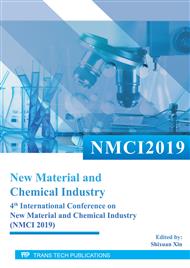p.115
p.121
p.127
p.135
p.145
p.153
p.160
p.168
p.174
Enhanced Red Fluorescence Emissions of [Ru(bpy)3]Cl2 in DNA Complexes
Abstract:
The research on molecular devices, fluorescent labels and fluorescent probes based on the interaction between biomolecular DNA and fluorescent dyes has been paid more attention at home and abroad. In this paper, the luminescence properties of the [Ru(bpy)3]Cl2 complex itself were investigated, and the luminescence properties of the [Ru(bpy)3]Cl2 complex under the interaction of the solution and the film were observed by association of the DNA complex with the [Ru(bpy)3]Cl2 complex. The results showed that [Ru(bpy)3]Cl2 emitted red light with its main emission peak wavelength was 610nm, and its fluorescence intensity was the highest when the concentration of solution substance was 10mmol/L. When doped with DNA solution in [Ru(bpy)3]Cl2 complex, a small amount of fluorescent dye [Ru(bpy)3]Cl2 can be used to achieve a higher luminous intensity At the same time, the fluorescent dye [Ru(bpy)3]Cl2 doped with DNA solution reached a higher luminous intensity in the thin-film state. This experiment provides an important experimental basis for the application of fluorescent substance [Ru(bpy)3]Cl2 in luminescent thin films.
Info:
Periodical:
Pages:
145-152
Citation:
Online since:
May 2020
Authors:
Price:
Сopyright:
© 2020 Trans Tech Publications Ltd. All Rights Reserved
Share:
Citation:


